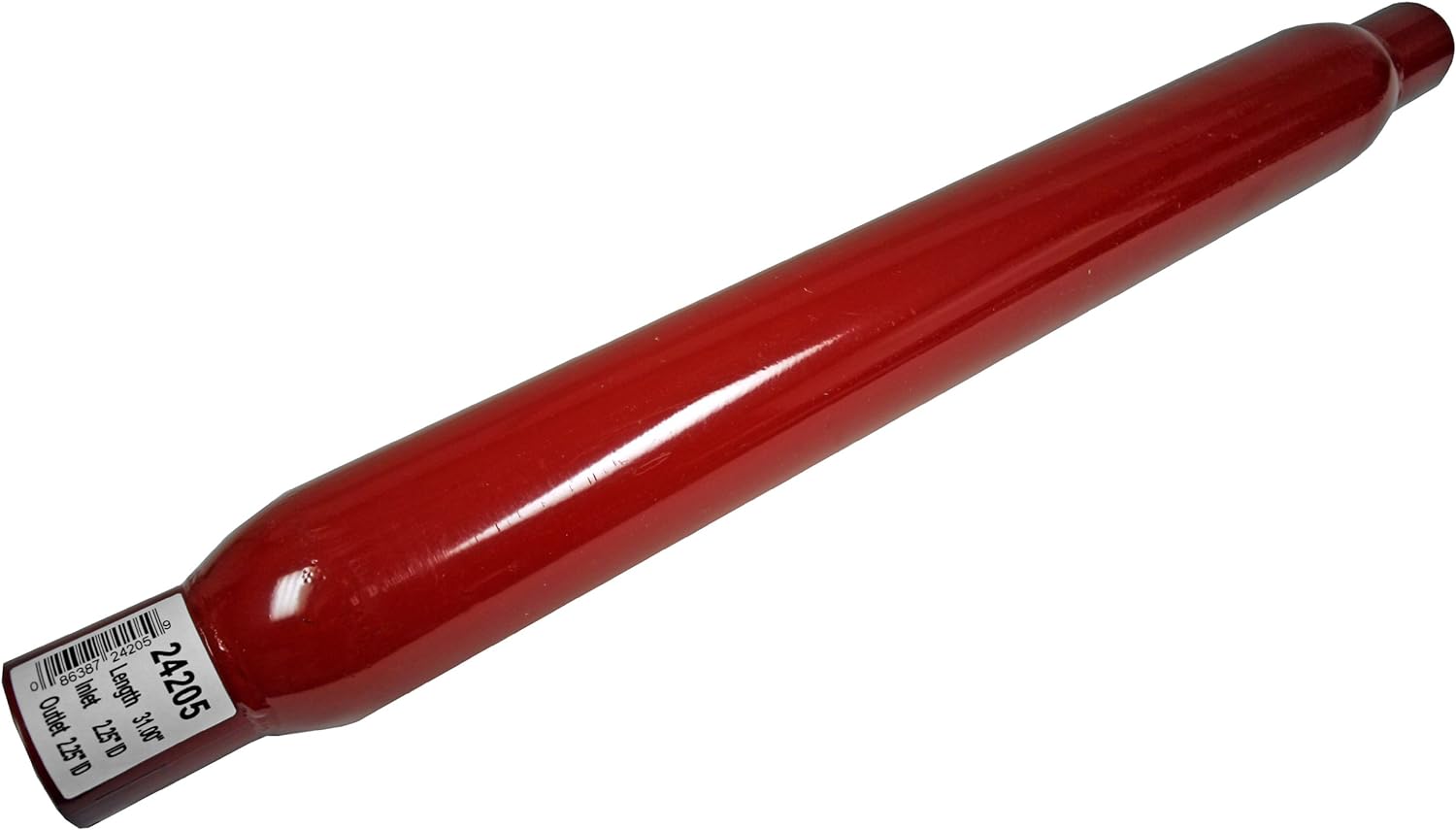Home>Furniture & Design>Interior Design Trends>What Is A Glass Pack


Interior Design Trends
What Is A Glass Pack
Modified: February 18, 2024
Discover the latest interior design trends with our guide to glass pack and how it can elevate your space. Explore innovative ideas and inspiration for your home.
(Many of the links in this article redirect to a specific reviewed product. Your purchase of these products through affiliate links helps to generate commission for Storables.com, at no extra cost. Learn more)
Introduction
Glass packs, also known as glasspack mufflers, are a popular choice for automotive enthusiasts seeking to enhance the performance and sound of their vehicles. These distinctive mufflers have a unique design that sets them apart from traditional muffler types, making them a sought-after option for those looking to customize their vehicle's exhaust system.
Glass packs are characterized by their compact size and straight-through design, which allows for minimal restriction of exhaust flow. This design feature contributes to the signature deep and aggressive exhaust note that glass packs are renowned for. As a result, they have become synonymous with the classic American muscle car sound, making them a desirable option for individuals aiming to achieve a powerful and distinctive auditory experience from their vehicle.
In addition to their performance and sound benefits, glass packs are favored for their compact and lightweight construction, making them a practical choice for vehicles with limited space for exhaust components. Their relatively simple design also makes them an attractive option for DIY enthusiasts looking to upgrade their vehicle's exhaust system without extensive modifications.
The appeal of glass packs extends beyond their functional benefits, as they are often chosen for their aesthetic appeal. The distinctive appearance of these mufflers, with their transparent glass or fiberglass packing material visible through the outer shell, adds a unique visual element to the vehicle's exhaust system.
In the following sections, we will delve deeper into the history of glass packs, explore how they work, weigh the pros and cons of using them, and highlight some popular brands that offer these performance-enhancing mufflers. Whether you are a seasoned automotive enthusiast or simply curious about aftermarket exhaust components, this comprehensive guide will provide valuable insights into the world of glass packs and their impact on vehicle performance and customization.
Key Takeaways:
- Glass packs are compact, lightweight mufflers that create a deep, aggressive exhaust sound, perfect for those who want to customize their vehicle’s auditory experience and potentially enhance its performance.
- Popular brands like Flowmaster, Cherry Bomb, and MagnaFlow offer top-tier glass packs known for their distinctive exhaust notes and performance optimization, catering to diverse preferences of automotive enthusiasts.
Read more: What Are Glass Packs
History of Glass Packs
The history of glass packs dates back to the mid-20th century, a time when automotive enthusiasts were increasingly seeking ways to customize and enhance the performance of their vehicles. The concept of glass pack mufflers emerged as a response to the growing demand for aftermarket exhaust components that could deliver improved engine efficiency and a distinct exhaust note.
The origins of glass packs can be traced to the post-World War II era, a period characterized by a surge in automotive innovation and customization. As car culture gained momentum in the United States, enthusiasts began experimenting with various modifications to amplify the performance and sound of their vehicles. It was during this time that the glass pack muffler, with its unique design and performance attributes, made its debut in the automotive aftermarket scene.
The term "glass pack" is believed to have originated from the visible glass or fiberglass packing material housed within the muffler's outer shell. This transparent packing material not only contributed to the muffler's name but also became a defining visual characteristic of glass packs. The use of this distinctive packing material was a departure from conventional muffler designs, setting glass packs apart as a novel and attention-grabbing option for automotive enthusiasts.
In the 1950s and 1960s, glass packs gained popularity among hot rodders and muscle car enthusiasts who sought to achieve a more aggressive and resonant exhaust tone. The straight-through design of glass packs allowed for minimal restriction of exhaust flow, resulting in a deep and distinctive exhaust note that became synonymous with American muscle cars of that era. This unique sound profile, coupled with the compact size and lightweight construction of glass packs, contributed to their widespread adoption in the automotive customization community.
Over the decades, the appeal of glass packs has endured, with enthusiasts and DIY modifiers continuing to embrace these mufflers for their performance, sound, and visual impact. As automotive technology has advanced, glass packs have evolved to incorporate modern materials and manufacturing techniques while retaining their characteristic straight-through design and signature exhaust note.
Today, the legacy of glass packs lives on as a testament to the enduring influence of automotive customization and the pursuit of individuality in vehicle performance and aesthetics. The rich history of glass packs reflects their enduring appeal and their status as a timeless icon in the realm of aftermarket automotive components.
How Glass Packs Work
Glass packs operate on a simple yet effective principle, leveraging their unique design to influence the flow and sound of exhaust gases. At the core of their functionality is the straight-through design, which sets them apart from conventional chambered mufflers. This design consists of a perforated inner tube surrounded by a layer of sound-absorbing material, typically glass or fiberglass packing, and an outer shell.
When exhaust gases exit the engine, they enter the glass pack muffler through the perforated inner tube. As the gases pass through the sound-absorbing material, the high-velocity flow and heat cause the exhaust sound waves to be disrupted and absorbed. This process is instrumental in reducing the noise produced by the exhaust system, resulting in a distinct and aggressive exhaust note that is characteristic of glass packs.
The straight-through design of glass packs also contributes to their performance-enhancing properties. By minimizing exhaust flow restriction, these mufflers facilitate efficient expulsion of exhaust gases, allowing the engine to operate with reduced back pressure. This can lead to improved engine breathing and, in some cases, a modest increase in horsepower and torque.
Furthermore, the compact size and lightweight construction of glass packs make them a practical choice for vehicles with limited space for exhaust components. Their relatively simple design also makes them an attractive option for DIY enthusiasts looking to upgrade their vehicle's exhaust system without extensive modifications.
In summary, the functionality of glass packs is rooted in their straight-through design, which enables them to influence exhaust flow and alter the sound profile of the vehicle. By leveraging the properties of sound-absorbing materials and a streamlined internal structure, glass packs deliver a unique auditory experience while potentially enhancing engine performance. These attributes have solidified glass packs as a popular choice for automotive enthusiasts seeking to customize their vehicle's exhaust system.
Pros and Cons of Glass Packs
Glass packs, with their distinctive design and performance attributes, offer a range of benefits and considerations for automotive enthusiasts. Understanding the pros and cons of these mufflers is essential for making informed decisions when customizing a vehicle's exhaust system.
Pros
-
Distinctive Exhaust Note: Glass packs are renowned for producing a deep and aggressive exhaust tone, often associated with classic American muscle cars. This distinct auditory experience adds a unique character to the vehicle's sound profile, appealing to enthusiasts seeking a powerful and resonant exhaust note.
-
Performance Enhancement: The straight-through design of glass packs minimizes exhaust flow restriction, potentially leading to improved engine breathing and reduced back pressure. This can result in modest gains in horsepower and torque, contributing to enhanced overall performance.
-
Compact and Lightweight: Glass packs are compact and lightweight, making them a practical choice for vehicles with limited space for exhaust components. Their relatively small size and streamlined construction offer flexibility in installation and compatibility with a wide range of vehicle types.
-
Aesthetic Appeal: The transparent glass or fiberglass packing material visible through the outer shell of glass packs adds a visually striking element to the vehicle's exhaust system. This unique visual feature can enhance the overall aesthetic appeal of the vehicle, especially for automotive enthusiasts who value customization and visual impact.
-
DIY-Friendly: The relatively simple design of glass packs makes them accessible to DIY enthusiasts looking to upgrade their vehicle's exhaust system without extensive modifications. Their straightforward installation process and compatibility with various vehicle configurations make them an attractive option for those seeking a hands-on customization experience.
Read more: What Are Glass Pack Mufflers
Cons
-
Sound Level: While the distinctive exhaust note of glass packs is a desirable trait for many enthusiasts, it may be perceived as too loud or aggressive for some individuals or specific driving environments. Local noise regulations and personal preferences regarding exhaust sound levels should be considered when opting for glass packs.
-
Minimal Sound Control: Unlike chambered mufflers that offer more sound control through internal baffles and chambers, glass packs provide limited sound modulation. This can result in a consistent and pronounced exhaust tone, which may not be suitable for those seeking adjustable sound profiles.
-
Durability Concerns: The exposed glass or fiberglass packing material in glass packs may be susceptible to degradation over time, especially in high-temperature and high-moisture environments. This can potentially impact the longevity and performance of the muffler, necessitating periodic inspection and maintenance.
-
Legal Compliance: Depending on local regulations, the installation of glass packs may require compliance with noise and emissions standards. Enthusiasts should ensure that the use of glass packs aligns with applicable laws and regulations to avoid potential legal issues or citations.
-
Limited Sound Tuning: Unlike some modern performance mufflers that offer adjustable sound tuning features, glass packs have a fixed design that may not cater to individuals seeking customizable sound modulation options.
Understanding the pros and cons of glass packs is crucial for enthusiasts considering these mufflers for their vehicles. By weighing the benefits and considerations, individuals can make informed decisions that align with their preferences, performance goals, and regulatory requirements.
Popular Brands of Glass Packs
When it comes to choosing glass packs for a vehicle, several reputable brands have established themselves as leaders in the aftermarket automotive industry. These brands are known for their commitment to quality, performance, and innovation, making them go-to choices for enthusiasts seeking top-tier glass pack mufflers. Let's explore some of the popular brands that have made a significant impact in the realm of glass packs:
1. Flowmaster
Flowmaster is a renowned name in the world of performance exhaust systems, and its range of glass pack mufflers exemplifies the brand's dedication to delivering exceptional sound and performance. With a focus on engineering exhaust solutions that cater to a wide range of vehicle applications, Flowmaster's glass packs are designed to provide a deep and aggressive exhaust tone while optimizing exhaust flow for enhanced engine performance.
2. Cherry Bomb
Cherry Bomb has been a prominent player in the aftermarket exhaust industry for decades, and its line of glass pack mufflers has garnered a loyal following among automotive enthusiasts. Known for their signature red color and distinctive sound, Cherry Bomb glass packs offer a classic muscle car exhaust note that resonates with enthusiasts seeking a timeless auditory experience.
Read more: How To Pack Glass
3. Thrush
Thrush, a brand under the Tenneco umbrella, has been a trusted name in the performance exhaust segment, offering a diverse selection of glass pack mufflers designed to deliver a bold and resonant exhaust tone. With a focus on combining performance and value, Thrush glass packs cater to enthusiasts looking for an impactful sound upgrade without compromising on quality.
4. Jones Exhaust
Jones Exhaust has carved out a niche in the aftermarket exhaust market with its range of high-quality glass pack mufflers. Emphasizing precision engineering and sound optimization, Jones Exhaust glass packs are engineered to produce a distinctive exhaust note that captures the essence of classic American muscle cars while enhancing overall engine performance.
5. MagnaFlow
MagnaFlow, a well-respected name in the performance exhaust industry, offers a selection of glass pack mufflers that embody the brand's commitment to superior craftsmanship and sound engineering. MagnaFlow glass packs are designed to deliver a deep and powerful exhaust tone, complemented by the brand's renowned attention to detail and performance-driven design.
These brands represent a diverse array of options for enthusiasts seeking high-quality glass pack mufflers, each with its unique approach to delivering a resonant exhaust note and performance enhancement. Whether it's the iconic sound of Cherry Bomb or the precision engineering of MagnaFlow, these popular brands have solidified their positions as go-to choices for automotive enthusiasts looking to elevate their vehicle's auditory and performance characteristics with top-tier glass packs.
Conclusion
In conclusion, glass packs have left an indelible mark on the automotive customization landscape, offering a unique blend of performance, sound, and visual appeal. From their humble beginnings in the mid-20th century to their enduring popularity in the modern automotive aftermarket, glass packs have continued to captivate enthusiasts and DIY modifiers alike.
The history of glass packs reflects the enduring spirit of automotive innovation and individuality, with these mufflers becoming synonymous with the iconic exhaust notes of classic American muscle cars. Their distinctive design, characterized by a transparent packing material visible through the outer shell, has contributed to their status as a visual standout in the realm of aftermarket exhaust components.
The functionality of glass packs, rooted in their straight-through design and sound-absorbing properties, underscores their ability to influence exhaust flow and alter the auditory experience of a vehicle. This unique combination of performance enhancement and a resonant exhaust note has cemented glass packs as a sought-after choice for enthusiasts seeking to customize their vehicle's sound profile and overall performance.
When considering the pros and cons of glass packs, it becomes evident that these mufflers offer a compelling array of benefits, including a distinctive exhaust note, potential performance gains, compact and lightweight construction, aesthetic appeal, and DIY-friendly installation. However, considerations such as sound levels, durability, legal compliance, and sound tuning limitations underscore the importance of informed decision-making when opting for glass packs.
Furthermore, the popularity of glass packs is underscored by the presence of reputable brands such as Flowmaster, Cherry Bomb, Thrush, Jones Exhaust, and MagnaFlow, each offering a distinct take on delivering a resonant exhaust tone and performance optimization. These brands have played a pivotal role in shaping the landscape of glass packs, catering to the diverse preferences and performance goals of automotive enthusiasts.
In essence, the enduring appeal of glass packs lies in their ability to deliver a visceral and impactful auditory experience while potentially enhancing the overall performance of a vehicle. Whether it's the nostalgia-inducing exhaust note reminiscent of classic muscle cars or the pursuit of personalized sound and performance, glass packs continue to resonate with automotive enthusiasts, embodying a timeless allure that transcends generations and automotive trends.
Frequently Asked Questions about What Is A Glass Pack
Was this page helpful?
At Storables.com, we guarantee accurate and reliable information. Our content, validated by Expert Board Contributors, is crafted following stringent Editorial Policies. We're committed to providing you with well-researched, expert-backed insights for all your informational needs.














0 thoughts on “What Is A Glass Pack”